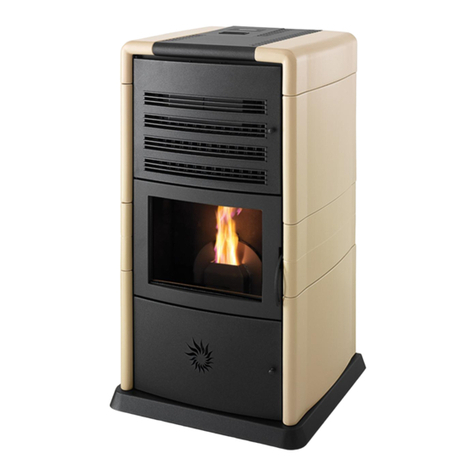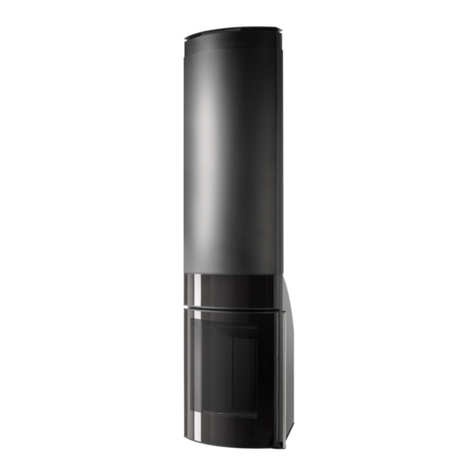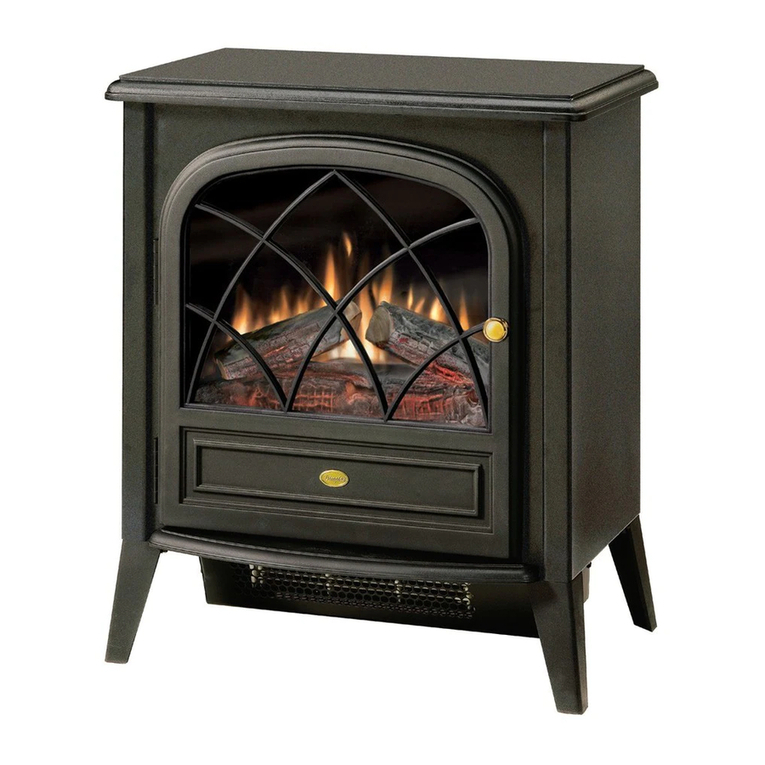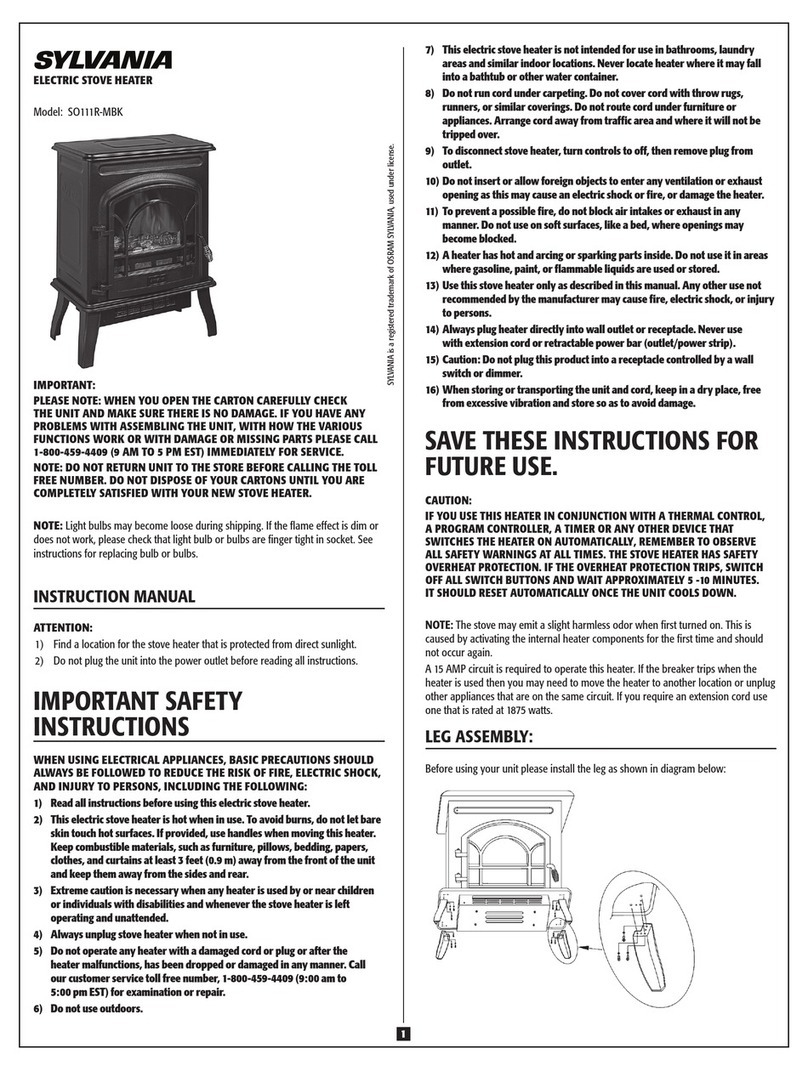CS THERMOS LADY User manual

INGLESE
cod. 6118007EN 04- 2012
Via Padania, 35 - 31020 S. Vendemiano (TV), ITALIA
INSTRUCTION MANUAL
Pellet Stove

ENGLISH
1
You have just purchased a high quality product produced entirely in Italy.
Reading this manual is very important to guarantee correct functioning of the product in regards to
safety and servicing of the machine.
A correct installation and initial set up of set up parameters is vital and therefore it is reserved for
technicians authorized by the manufacturer as is periodic maintenance.
Cleaning is an important element for safety maintenance and for product functioning, and must be
carried out periodically to guarantee a long life and for keeping people and the machine safe.
This manual is relevant for all CS TH RMOS air models.
INDEX
1 Safety warnings ............................................................................................................................ 2
2 Product description ................................................................................................................... 3
3 Pellet qality .................................................................................................................................... 3
4 Si e data.......................................................................................................................................... 4
5 Technical data............................................................................................................................... 5
6 General rules for the reali ation of the flue........................................................................ 6
7 Execution of smoke discharge ................................................................................................. 7
8 Oxidising air intake..................................................................................................................... 8
9 Electrical connection ................................................................................................................ 9
10 Preliminary checks for the first start up ........................................................................... 10
11 Control panel display .................................................................................................................11
12 Operational phases ....................................................................................................................11
13 Programming .............................................................................................................................. 12
14 Alarm signalling ......................................................................................................................... 14
15 Replacing the ceramics............................................................................................................ 15
16 Care and maintenance ............................................................................................................. 15

ENGLISH
2
1. SAFETY WARNINGS
DO NOTuse different combustibles from the pellets (small pressed wooden trunks with a diameter of
6-8mm and a length of 5-20mm- see related chapter)
DO NOTuse any flammable liquids to light the stove
DO NOT light the stove if the glass window is damaged and do not, for any reason, open the fire
box door during functioning.
ONLY clean the glass window when the stove is cold, using a specific cleaning detergent with a
cotton cloth or kitchen paper.
DO NOTuse abrasive products for surface cleaning
DO NOTunplug the stove if there are flames in the crucible
Take care when the stove is functioning: the hot parts (glass, handle, etc...) can cause burning.
Keep out of reach of children.
Unplug the machine before any kind of maintenance or cleaning
DO NOTplace hands inside the tank during functioning.
At first start-up ensure that the upper hearth surface is correctly positioned (except for models
SARA, KARINA, NIKO and ECONOMICA)
Never throw un-burnt pellets into the tank: risk of ignition
Never throw pellets manually into the crucible especially if there are flames or hot ashes
Possible unpleasant odours during functioning could be caused by the type of pellets used
Possible noises during functioning are normal, as they are subsidence of assembled parts
WARNING: (see UNI10683 standard)
A natural force draught in the flue between 10 and 12 Pa must be guaranteed to avoid smoke filling the
room or overheating of electric components, should the electric power be cut or adverse ambient conditions
arise.

ENGLISH
3
2. PRODUCT DESCRIPTION
All stove modelsare equipped with an electrical grid for functioning and combustion control, and can modulate
their power according to settings set from the display, this way allowing better adaptation to heating
requirements.
During initial start up phase (approx 10 min) the crucible automatically fills with combustibles, whilst the
resistors heat up and ignite them. After the presence of a flame has been detected by combustion smoke
detectors, normal functioning starts and, thanks to the microprocessor, permits the variation of combustibles
contribution byacting on the auger motor and modulating the flame.
At everypointthe electronic grid controls the temperature sensorsas well as the safetydevicesand, in case of
anomalies, it will stop functioning and signal this on the display (see alarm code paragraph).
Room heating is guaranteed byan air flow thatisvariable according to functioning power that passes the tube
sectioning for combustion smoke. For models covered in ceramics or majolica, the thermal exchange in the
room will be warmer and more pleasant
3. PELLET QUALITY
There are various types and qualitiesof pellets on the market and it isimportant that the onesyou use are not
of abysmal quality. A poor, cheap quality pellet could contain glues, resins or chemical substances that could
seriously jeopardise the functioning and the safety of the product, by inciting blockage of ashes and smoke
discharger, forming corrosive gas, reducing machine performance, release polluting substances into the
atmosphere and window incrustation. Laws in force on the matter state that products that use this type of
combustion have to be fed with good quality pellets that are well compacted and not very powdery. We
recommend that you ask your retailer for suitable pelletsthat are in compliance with DIN51731 standards or
M7135 standards including any updates
Wooden pellet characteristics should be: of a 6÷8 mm diameter, approx.5÷20 mm length, have an 8% humidity
and a heating potential of 18200 KJ/Kg.
The manufacturer does not assume any responsibility for use of poor quality pellets and therefore is
non respondent to consequent malfunctioning of the stove..
Store pellets at least 1 metre away from the stove in a dry and shelteredpart of the room.

ENGLISH
4
4.SIZE DATA
ECONOMICA
STILE
SARA
NIKO
ARMONIA
LADY
KARINA
BRAVA

ENGLISH
5
5. TECHNICAL DATA
MODEL
UNIT OF
MEASUREM
ENT
ARMONIA LADY STILE BRAVA KARINA SARA NIKO ECONOMICA
HEARTH THERMAL POWER kW 4÷11,7 4÷14,5 4÷14,5 4÷11,7 4÷8,5 4÷8,5 4÷8,5 3,5÷7
NOMINAL THERMAL POW ER kW 2,8÷9,5 2,8÷11,2 2,8÷11,2 2,8÷9,5 2,8÷6,7 2,8÷6,7 2,8÷6,7 2,5÷5,5
PERFORMANCE % 77* 77* 77* 77* 80* 80* 80* 80*
CO EMISSION ppm 390 390 390 390 390 390 390 390
PELLE T HOLD CAPACITY Kg ~14 ~18 ~18 ~15 ~ 12 ~12 ~ 12 ~ 12
HEATING VOLUME m3 230 max 300 max 300 max 230 max 165 max 165 max 165 max 150 max
DIAMETER OF SM OKE
OUTLET mm 80 80 80 80 80 80 80 80
DIAMETER OF EXTRACTION
PASSAGE mm 80 80 80 80 80 80 80 80
SMOKE TEMPERATURE °C 120÷260 120÷260 120÷260 120÷260 120÷260 120÷260 120÷260 120÷260
ELECTRICAL POWER V V230~ / 50Hz V230~ / 50Hz V230~ / 50Hz V230~ / 50Hz V230~ / 50Hz V230~ / 50Hz V230~ / 50Hz V230~ / 50Hz
MAXIMUM INPUT A 3 3 3 3 3 3 3 3
AVERAGE INPUT DURING
FUNCTIONING W70 70 70 70 70 70 70 70
INPUT DURING STA RT-UP W max 600 max 600 max 600 max 600 max 600 m ax 600 max 600 max 600
NOISE dB <60 <60 <60 <60 < 60 <60 < 60 <60
OVERALL DIMENSIONS mm see relevant
chapter see relevant
chapter see relevant
chapter see relevant
chapter see relevant
chapter see relevant
chapter see relevant
chapter see relevant
chapter
NE T WEIGHT Kg 230 163 143 132 123 95 92 114
COVERING majolica ceramics m etal ceramics ceram ics ceramics metal metal
Kg/h max 2,4** max 3** max 3** m ax 2,4** max 1,9**
PELLET Ø 6÷8m m x
5÷20mm Ø 6÷8mm x
5÷20mm Ø 6÷8mm x
5÷20mm
CONSUMMATION A T MAXIMUM
POWER
MAXIMUM AUTONOM Y WITH
CONTINUOS FUNCTIONING AT
POWER 1
Ø 6÷8mm x
5÷20mm Ø 6÷8mm x
5÷20mm Ø6÷8mm x
5÷20mm Ø 6÷8mm x
5÷20mm
max 1,9** max 1,9**
Ø 6÷8m m x
5÷20mm
max 13** ore
max 1,9**
COMBUSTIBLE
max 16** ore max 13** ore max 13** ore m ax 13** ore
ORE max 15** ore max 20** ore max 20** ore
* Performance measured at maximum power in laboratory testing optimal installation conditions.
** The data was obtained from laboratory testing at optimal conditions. The consummation in hours may very according of pellet used and installation.

ENGLISH
6
6. GENERAL RULES FOR THE REALIZATION OF THE FLUE
Here are illustrated a few simple yet important rules to follow for the safe construction of the flue (for further
information, please read the UNI 10683 regulation)
• The safe and correct functioning of the pellet stove is dependant on the connection to a single and
independent flue. No other fireplace, stove, boiler, aspiring hoods etc... are to be connected to the same
flue (see fig.3).
•This machine needs to expel products resulting from combustion via a vertical flue that has a suction
pressure between 6 and 10 Pa, in order to constantly guarantee the expulsion of smoke, even with the
absence of electric power oradverse conditions.
•The part of the flue that extrudes from the roof or remainsin external contact must be covered with tilesor at
least well insulated.
• The stackmust be wind resistant, have an internal section that isequal to that of the flue, a useful section at
least twice the size of the flue, and prevent entering of rain.
• Any other building parts, plants or other obstacles that are higher than the roof must be positioned at least
3m away from the flue.(see fig.4).
• Whenever two flues with parallel exits are used, it is advisable to lift the wind resistant flue (see fig. 5).
The flue section must be uniform, with smooth surfaces that do not narrow down, and the curvesmust be
regulated, without discontinuity.
It is advisable that the smoke conduct has a solid material and eventual condensation collecting box,
positioned under the smoke conduct intake, so that it is easily accessible and can be inspected from the
airtight door.
Fig.4
Fig.5
SI NO
YES
NO
SI
YES
Fig.3

ENGLISH
7
7. EXECUTION OF SMO E DISCHARGE
Smoke discharge must comply with regulations in vigour and therefore must happen via the roof and end over
the roof level. The discharge tube must be made out of smooth steel with silicon seal and not be corrugated
flexible type. Furthermore it must be positioned externally and not in closed or semi-closed spaces. For
example:garages, narrow corridors, under closed penthousesor any other places where smoke could collect.
When connecting the stove to a flue, make sure, with a professional chimney sweep, that the flue is perfectly
whole.. Oppositely it is absolutely obligatory to encase the existing flue with material which issuitable enough
to ensure correct functioning (see fig.7).
TYPE OFTUBES FOR FLUES
Rigid painted steel tubesshould be used, and should be at least 1.5mm thick, alternatively they can be made
out of stainless steel which isat least 0.5mm thick. The male/female coupling collarsmust be superimposed by
at least 40mm. For INSERTO CAMINETTO model use 600°C flexible silicon tubing, with double smooth wall
inside, up until connected to the flue.
FLUE TUBING DIAMETER
The diameter of the tubes depends on the type of system. The stove has been designed for tubes with an
80mm diameter, asshown in the table, howeverin some cases 100mm isadvisable. If 100mm diameter tubing
isnecessary, connect it to the stove using a "T" pipe connection with a ø80 -ø100 pipe connection (see fig. 8)
FLUE
DIAMETER
ESTIMATIO
N
Length oftube length less than 5 mt
80 mm
Correct
Length oftube length more than 5 mt
100 mm
Obligatory
For installations at an altitude above 1200 mt a.s.l.
100 mm
Recommended
Note: for every 90°curveadd 1m and for every 45° add 1/2m. The lengths indicatedonthe tablearerelevant for vertical tubing.
Horizontal parts must not be longer than twometres.
It is obligatory to use a "T" connection tube (see fig.8) with an inspection plug, as a connection between the
stove and the flue, which will allow both the collection of ash that is deposited inside the tubes and periodical
cleaning ofthe flue, without the need to dismantle. Seeing that the smoke isunder a light pressure, ensure that
the plug for cleaning the flue has a tight fitting and that it remains so after cleaning. Remember to fix it backas
it wasand checkthe conditionsof the seal. Checkthat the connections between varioustubesare in order, as
indicated by the manufacturer.
It is strongly advised not to place tubeshorizontally, but if absolutely necessary make sure they are placed with
an angle of at least 5°.
If a traditional flue is used it is possible to connect without the need for a "T" connection tube, but you must
checkthat the flue hasa box for collecting ash.
It is advisable to connect to the stove with a horizontal track that is not more than 1m long.
If the lengths of the tubesare correct the flue should have a suction pressure between 10 and 15 Pa.
Do not change sectionsof tubing half way and above all after a bend or a horizontal tract. Checkthat there is
no narrowing in the tubing or the flue.
ISOLATION AND DIAMETER OF HOLES IN WALLS OR ONTHE ROOF
Once the position of the stove isestablished and that you have checked that the place of installation is ideal, it
isthen necessary to make the hole for passing tubes through the wall. Thiscan vary according to the type of
installation, the diameter ofthe tube and the type of wall or roof where the hole ismade.
N.B.: if the floor can not support the weight of the stove, position a sheet platform of the correct size with
insulation applied on the floor (rockwool) and with a nominal density greaterthan 80kg/mc

ENGLISH
8
END PART OFTHE FLUE SYSTEM
The stack must not be installed in spaces that are closed, poorly ventilated or, in general, where smoke can
collect.
It isnecessary to checkthat there are no flammable elements (plants, wood) or elementsthat could be visually
damaged (walls, windows) within 3m of the flue.
WARNING: Seeing that regulations regarding installation of pellet fuelled stoves are constantly being
updated, ask ones installer for eventual changes.
8. OXIDISING AIR INTA E
Oxidising air can be taken from the atmosphere as long as there is sufficient ventilation, otherwise it is
necessary to extend the tube of the air intake: in this manner it is possible to guarantee an optimal combustion
without having to open air intakes in the room. For both cases please refer to the installation regulations in
vigour to avoid health risks of those who are in the room where the machine hasbeen installed.
Do not use flexible tubes and place a grid over the entrance (external) of the tube in order to stop alien
elements entering the system which could jeopardise the correct functioning.
MINIMUM DISTANCES FORTHE POSITIONING OFTHE AIRINTAKE
For correct and safe positioning of the air intake (see
fig.9) where the minimum distances for any opening
are indicated.
It is important to be aware of other wall discharges of
other machinesor kitchen hoods.
Fig.7
Fig.8
Raccordo 80-100
Raccordo a "T"
Ø 80
Ø 100
DIREZIONE DI
PULIZIA
CLEANING
DIRECTION
JOINT
“T”
JOINT
Fig. 9
AIR INTAKE

ENGLISH
9
9. ELECTRICAL CONNECTION
All machines are equipped with power cables, for which, in case of the need for replacing, an authorized
technician must be used.
Before connecting to the power supply, check that:
•the electric plant hasbeen fitted with a 6A magneto thermal switch
•The characteristics of the plant are sufficient enough to satisfy what is indicated on the machine
characteristicplaque (electric power, nominal voltage etc...)
•The plant hasa sufficient earth connection according to nominal regulationsin vigour (earth connection is
obligatory by law)
•The power cable should never, at any point, overheat 50°C above room temperature: If a direct connection
isdesired, it is necessary to use an omni polar switch, with a minimum opening between contacts of 3mm,
that hasbeen designed for the electrical charge indicated on the plaque and must correspond to regulations
in vigour. the earth wire, brown/green, should not be interrupted by the switch! The plug oromni polar switch
should be easilyaccessible once the machine hasbeen installed.
In case ofa prolonged disuse of the machine, disconnect the power supply.
The manufacturer declines any responsibility if what stated above or in actual anti-injury laws are
not respected.
INTERNAL ELECTRICAL PLAN
DISPLAY
L
N
PRESS
+FUMI- T.CALD.
FU MI
V. AMB.
POWER SUPPLY
230V - 50Hz~
ELECTRICAL
RESISTORS
GAS SAFETY
THERMO STAT
AUGER SAFETY
THERMO STAT
PELLET LOADING
AUGER MOTOR
AIR PRESSURE
SWITCH
FUSE
4 A
PROG RAM MING
PORT
FUMES FAN
ENCO DER
CLOCK
BATTERY
FLUE GAS
MOTOR HEATING FAN
MOTOR
GAS
PROBE
ROOM
PROBE

ENGLISH
10
10. PRELIMINARY CHEC S FOR THE FIRST START UP
OBLIGATORY GUIDE LINES FORTHE SAFETY OF PEOPLE; ANIMALS AND OBJECTS.
The following information is about a number of obligatory general regulations for a correct instalment, and is
intended for the installer.
• It is recommended to place insulation between the floor and the touching points of the machine with a
sheet at least 2mm thick and a diameter at least 50mm greater than the area occupied by the machine, if
the stove isinstalled on top of a wooden floor.
• The flue tubing must have a diameterof at least 80mm.
• Leave a space of at least 50 mm between the outer sheeting of the stove and the wall in order to ensure
correct airintake of the air that will go on to be heated by the stove, and also to allow easy removal of the
air filter for cleaning.
•Should the machine be installed close to flammable walls, keep a safe distance of 30cm from the rear and
sidesof the machine. Avoid leaving any type of flammable or combustible materials within 1m of the heat
waves from the glass window situated on the front of the machine. If installed on a floor made out of
flammable material place a sheet at least 3mm thick, 30cm away from the front of the machine and 10cm
form the side.
•For built in installation of ECONOMICA model in contact with flammable materials, place all around the
frame of the plate and the material, an insulating sheet at least 20mm thick. Should there be a shelf
positioned above the plate, made out of flammable material, keep a distance of at least 60cm.
•For the INSERTO model, neverinstall the machine with built in flammable material.
•Checkfor a correct level of combustible load inside the crucible.
•For the ECONOMICA model, remove oil residuesthat protect the upper plate.
For the first few minutesthat the machine operates(for the first time)it maybe possible to smell paint:
thisisnormal. Aerate the room with the machine operational.

ENGLISH
11
11. CONTROL PANEL DISPLAY
DESCRIPTION OF DISPLAY BUTTONS
Key - turnsthe stove on and off in manual mode (holding it for 2 seconds), eliminatesalarms and exits
programming
Key - changes the screen and confirmsset data
Key - key for increasing valuesbeing set
Key - key for decreasing valuesbeing set
MEANING OF LED LIGHTS
When the led if "permanently" onitmeansthatonce the set room temperature has been reachedit will stayonat
thelowest setting.
The "blinking"led communicatesthat once the set room temperaturehasbeen reached the stove will turn off.
When the led isturned off itmean the set room temperature hasbeen reached.
When the led isturned on it meansthat hourlyprogramming forautomatic operation hasbeen set.
12. OPERATIONAL PHASES
DISPLAY MEANING
Clean.
Pre-ventilation and safety controlsphase, with fire pot cleaning before loading fuel.
Charged
Start-up phase with fuel load in the burner while supplying power to the resistorsat the
same time.
Pause
Pause while awaiting flame.
St. Fire
Waiting phase during which the start-up must take place.
Stabil.
Stabilization phase, after the flame has started, with a medium size load of fuel.
Fire
Burneroperational adjustment phase where power can variesfrom 1 to 6
Turn off
Timed turn off phase associated to an interruption in the fuel for fire pot cleaning and
waiting for the flame to be totally extinguished.
Off
Turned off statusuntil there is an following request forheat
Stand by
Turn off because room temperature hasbeen reached
IN CASE OF AN ALARM, WAIT FOR THE END OF THE TURNING OFF PHASE
Set
Set day and time
Operational
Room temperature recorded
Room temperature requested
Operational power
Mer 09:00 20,0°C
Accesa 5 25,0°C

ENGLISH
12
13. PROGRAMMING
MAIN SETTINGS
Use the keys as instructed to access the desiredsetting
The menu “LOAD” allows tovary the quantity of combustible to be loaded andit is subdivided
into 3 levels of increase (+)and 3 levels of decrease (-): eachlevel consists of 0,2 seconds,
therefore a total of +/- 0,6 seconds.
Any variation made remains in permanent memory and itis simultaneously programmed on all 6 power
levels of the stove.
Sun 09:00 20,0°C
T. room
Hours
Ignition
Function
Combustible Combustible
Pellet1
Heating air Heating air
Trigger
T. room
Day of the
Trigger
Off 5 25,0°C
ESC SET
ESC SET
ESC SET
ESC SET
ESC SET
ESC SET 01
modulation YES
25,0°C
week Sun
timer YES
ESC
ON00:00 OFF00:00
Load
Load
ESC SET
- _ _ _ 0 _ _ _ +
00:00
See specific
chapter
Hors
Timer01 mtwtfss

ENGLISH
13
AUTOMATIC START-UP PROGRAMMING
Turning off for each time slot must not terminate after 23:59 of that day
Activate
Timer01 mtwtfss
Timer02 mtwtfss
Timer02 mtwtfss
Timer02 mtwtfss
Timer02 MTWTFss
Timer02 MTWTFss
Timer02 MTWTFss
Timer02 MTWTFss
Timer02 MTWTFss
Timer02 MTWTFss
timer yes
ON00:00 OFF00:00
ON00:00 OFF00:00
ON00:00 OFF00:00
ON00:00 OFF00:00
ON00:00 OFF00:00
Press to modify
Press to modify
Press to modify
Press to modify
Press to modify
Press to modify
Press to modify
Press to modify
Press the key to confirm
Press the key to modify
Press the keyto modify
Pressthe keyto confirm
Press the key to confirm
Press the key to confirm
Pressthe keyto confirm
Press the key
ON00:00 OFF00:00
ON00:00 OFF00:00
ON08:30 OFF00:00
ON08:30 OFF00:00
ON08:30 OFF00:00

ENGLISH
14
14. ALARM CODES
For your own safety do not tamper or modify any of the machine's components: the
manufacturer does not guarantee the normal operation, that as a result may be very dangerous.
In case of malfunctioning, difficulties, or whenever a safety device is activated, it is important to
contact authorised personnel. All operations must take place when the stove is coldand disconnected
from the power supply.
DISPLAY MEANING
Motor flue gas
Non working fumesmotor: contact an authorised technician
1 heat.elem.KO One of the resistorsisnot working: contactan authorised technician
2 heat.elem.KO Both resistorsare not working: contact an authorised technician
heat.element KO The resistorsare continually supplied with power: contact an authorised technician
gas probe The fumestemperature probe isinterrupted or disconnected: contact an authorised
technician
room probe The room temperature probe is interrupted ordisconnected: contact an authorised
technician
Thermostat gas Intervention on the partof the fumes discharge safety thermostat clean the inside of
the stove, reset the thermostat and restart the stove
Thermostat auger Intervention on the partof the fuel auger safety thermostat: clean the inside of the
stove, reset the thermostat and restart the stove
Pressure switch Air pressure regulatorisnot working: contact an authorised technician
system error Internal error of the electronic control box: turn stove off and restart it
black out Loss of electricpower: clean the burner and restart
Failed ignition Failed start-up: clean the burner and restart
Turn off fire Flame turns off while operating: clean the burner and restart
O er heating gas Overheating of combustion fumes: clean the stove completely and restart.
Cont. operation Malfunctioning of pellet loading motor: contact an authorised technician.
ser i ce Stove maintenance warning: contact an authorised technician
TO RESTORE STOVE OPERATION KEEP THE KEY PRESSED FOR 3 SECONDS

ENGLISH
15
15. REPLACING THE CERAMICS
For machines in ceramics disassembly and reassembly of individual parts must be done taking great care as
not to damage the parts.
Use both hands to remove the ceramics (fig 16) and lift each piece upwards, vertically, ALWAYS remove the
upper ceramicsand workdownwards, ensuring not to bend single supports (fig. 17).
To reassemble the piecesdo the opposite, ensuring that every hole of the ceramic meetsthe support, before it
ispushed downwards, using little force until the part isin place.
16. CARE AND MAINTENANCE
To ensure correct functioning and maximum efficiency of the stove, carry outthe following weeklymaintenance
operations
THE FOLLOWING OPERATIONS NEED TO BE DONE WHEN THE STOVE IS COLD
PELLET CRUCIBLE
For correct functioning of the machine it isimportant that the crucible (fig.19) is emptied after every use (once
cold). After every three usesit isadvisable to take it out, remove all the ash and pellet residue and to correctly
reposition it.
The crucible has a mesh that can be taken out or put backaccording to the type of pellet and desired power
used: askyour authorized After SalesService Centre how to use the mesh correctly.
Fig.16
Fig.17
Fig.
19
Fig.20

ENGLISH
16
ASH BOX
Carry out the following at least once per week:
Open the door under the hearth, unscrew the nut and remove the ash box with care.
Empty or clean out all the ash when the stove is cold, taking care that there are no
cinderspresent. Place the box backin itsplace an tighten the nut.
In ARMONIA and INSERTO CAMINETTO models the box can not be
removed, therefore after removing the crucible suck out the ash present on the
bottom with a vacuum.
INSIDE THE HEARTH
Carry out the following at least once per week:
Open the door of the combustion room and remove the crucible. Remove the
fixings (fig. 25) and remove the hearth sides from the combustion room: a
central one, two side one and an upper one (when present with the model)
checking the state of the pyroceram fibre ring (fig.26) that, when required, is
to be replaced only by a qualified person. Now remove all the ash present
inside the inspecting bulkheads (fig.27) and behind the door (when present
with the model) placed under the falling pellet tube.
Furthermore, especially check for, and remove, ash from the sidesof the tubing (fig.28) placed in the upper part
of the combustion room.
COMBUSTION SMOKE TUBING
The combustion smoke tubing and the entire flue must be checked and cleaned at least once a year. We
recommend the use of a specialized technician for thorough and professional cleaning.
COMBUSTION AIR INTAKE
During weekly cleaning remember to check that the air intake tube (fig.29)
positioned under the start-up resistors is not blocked by any alien material. If
necessary remove it.
Fig. 24
Fig.
27
Fig. 26
Fig. 25
Fig. 28
Fig. 29

ENGLISH
17
HEARTH GLASS DOOR
The glassused for the stovesis ceramic, resistant to high temperatures. Should it be damaged (e.g. chipped)it
isrecommended to have it replaced immediately by an authorized technician before using the machine again.
To clean, use a non abrasive cloth with specificliquid for glasscleaning.
DO NOT attempt to repair damaged glass, replace it: as there isa riskof explosion during functioning!
HEATEXCHANGING TUBE CHANNELLING
According to the model, there are one or two levers (fig.30) for internal cleaning
placed along side the hot air outlet. . It is advisable to move these levers both
ways at least once a day when the stove is cold, in order to let all the combustion
residues fall into the ash box.
HEARTH DOOR SEAL
Frequently checkthe conditionsof the seal fixed along the internal border of the hearth door to ensure a tight
closure.
Note: check the tightness of the seal by inserting a piece of paper into the crack of the door whilst shut,
ensuring that this process is possible but proves difficult. If this is not the case contact an authorized after
sales service centre to have the seal replaced.
AIR FILTER
Every 15 days remove the air filter positioned behind the stove (according
to the model) pulling from an angle and cleaning it with low pressure air or
vacuum or wash it under running water, drying it before repositioning it
(fig.31).
GENERAL END OF SEASON CLEANING
After use, at the end of the season, clean and checkall the partsindicated above, remembering to disconnect
the power supplyof the stove for increased safety.
It is advisable to check and clean the machine at least once per year by an authorized technician to ensure
correct functioning.
It is recommended, when required, to check lubrication of the pellet auger bronze bearings.
Fig.3
Fig.30
This manual suits for next models
7
Table of contents
Other CS THERMOS Stove manuals
Popular Stove manuals by other brands

StoveTec
StoveTec Wood/Charcoal Stove manual

Palazzetti
Palazzetti V15 Installation and maintenance manual

Windhager
Windhager BIOWIN 2 TOUCH installation instructions

Dunsley Heat
Dunsley Heat Highlander 10 Installation and operating insctructions

Hunter Stoves
Hunter Stoves AVALON 4 Instructions for Installation/Operating/Maintenance/Servicing
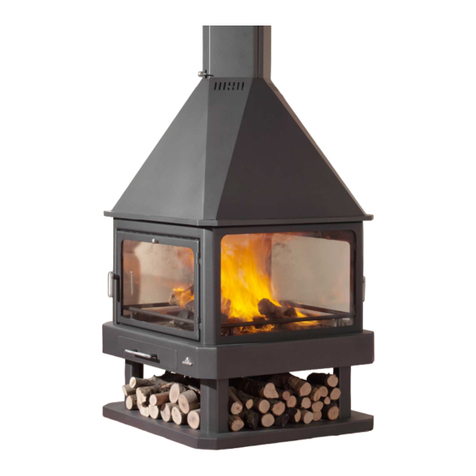
Bronpi
Bronpi HUELVA instruction manual

